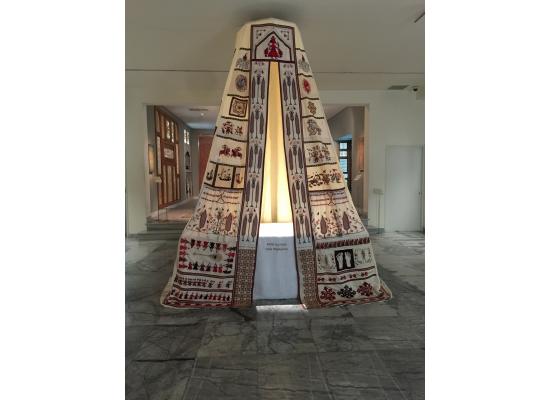Sperveri
400 cm x 220 cm x 110 cm
various embroidery styles and free style filling with threads, palestinian cross-stitch technique, all done with polyester, cotton and silk threads, acrylic paint, curcuma, pencils and threads on linen and cotton - 2017
Sperveri is a conceptual work made as a memorial for individuals who recently passed away because of wars and exodus.
--------------------------------
Title of the work, Sperveri
In Rhodes, the closest Greek Island to Turkey, a Sperveri is a bed-tent, which was hand-embroidered and decorated to cover the nuptial bed. Sperveri is also known as a dance done at the wedding on the island of Rhodes. It is sung and danced as part of the dressing of the bridal bed. The sperveri refers to the ornate covering of the bridal bed. It is a women's dance. The dance is also accompanied by a song with the title έστολισαν το σπερβερι.
About the work
In the past years, while making “I Strongly Believe in Our Right to be Frivolous”, a body of work where I register in portraits and in writing encounters with people who were forced to flee their home because of current conflicts, I encountered persons who had the urge to count to me their personal losses. Losses of their beloved ones, or even their own body parts because of wars in their countries or while they were trying to escape those wars, or when they reached Europe thinking it will be a safer place for them to survive in dignity. I encountered those people in Beirut, in Athens, in Kassel and in the Netherlands. Athens, being the middle point and a place where many people are strained before they are allowed or they manage to continue their journey to the North of Europe, is the main inspirational point behind this work.
For a few months, I studied and observed old Greek embroideries, created and embroidered by Greek women throughout the centuries, in the Islands, and on various places in Greece, from the 19th century, and from the Ottoman times, as well as embroideries from Byzantine times, (they are part of the Benaki Historical and Islamic collections), and I found many common points between these embroideries, what they symbolize, how they reflect the worries or the wishes of the women who embroidered them and their families, in todays’ atrocious stories told to me by people who were recently forced to escape their countries. I also found many common points between those embroideries and embroideries from our region in Lebanon and in Palestine and around.
As a final result, while on the surface of the bed-tent, we see a selection of those old Greek embroideries, when we read the texts hidden inside the Sperveri, we will hopefully make connections with the embroidered figurative elements outside the Sperveri.
The Peacock for instance which in old Greek embroidery (even dating back to Byzantine times) was a symbol of fertility and eternity, is often embroidered at the gate of the Sperveri. One of the stories we read inside of the bed-tent for instance is about a man who’s background is Yezidi. Yezidis are one of the oldest religious groups, venerating the Peacock in Northern Iraq in this case. I hope these connections will be subtly noticed by the readers and the spectators of this work, as they read the carefully embroidered stories inside the bed-tent, and they see the embroidered elements on its outside.
To acheive the Sperveri on time, I embroidered my carefully chosen elements that I re-drew on textile, with the assistance of family members and mostly skilled house-wives, some of them are refugees who were forced to come recently live in Lebanon in the camps, escaping the Syrian war, some others are Palestinian refugees, who still live in Camps in Lebanon since the seventies, if not earlier, and others are Lebanese Druze women who live in the mountains and usually sit for hours and embroider to earn their living, since most of the times the husbands are very old, or are not supporting their families anymore.
The current Sperveri is made after the exact dimensions of one of the few original Sperveris, from 19th century and the only one displayed at the Historical Benaki in Athens. The reason why Sperveris didn’t last, is that often women, after their wedding times are over, they would need for instance to make cushions for their house, or a dress for their daughters or a shirt for their boys, etc,.. so they would use parts of their hand-embroidered Sperveris according to their needs. It is also reflecting as I feel the history of exile, often while on exile, valuable things have no more meaning, and we have to be practical in order to fill in the missing gaps in our new life.
Furthermore, I find that embroidery itself carries traces of displacement, for instance if a bride marries a man from another region, she would go to live with him, carrying with her embroideries’ skills from her region, and thus it is often hard to trace the first source of certain embroidery styles.
---------------------------
Thanks to
With special thanks to Sfeir-Semler Gallery for offering me the backspace of their gallery in Beirut to be able to finalise the work.
Embroidering assistants: Nour el Houda Wahab, Fatimah El Hamada and her team, Souad Al Bitar, Zeina Chaccour, Louise Boutan, Balsam Abouzour, Salam Shokor, the Melki family, Bariaa Fakhoury Bdeir, Taghreed Mohammad, Soubhya Kourayyem.
With Special thanks to Rachel Dedman and Nour el Houda Wahab, on their technical advise and for sharing their expertise to help me realize this work.
This work was commissioned by Documenta 14 - Athens, 2017
